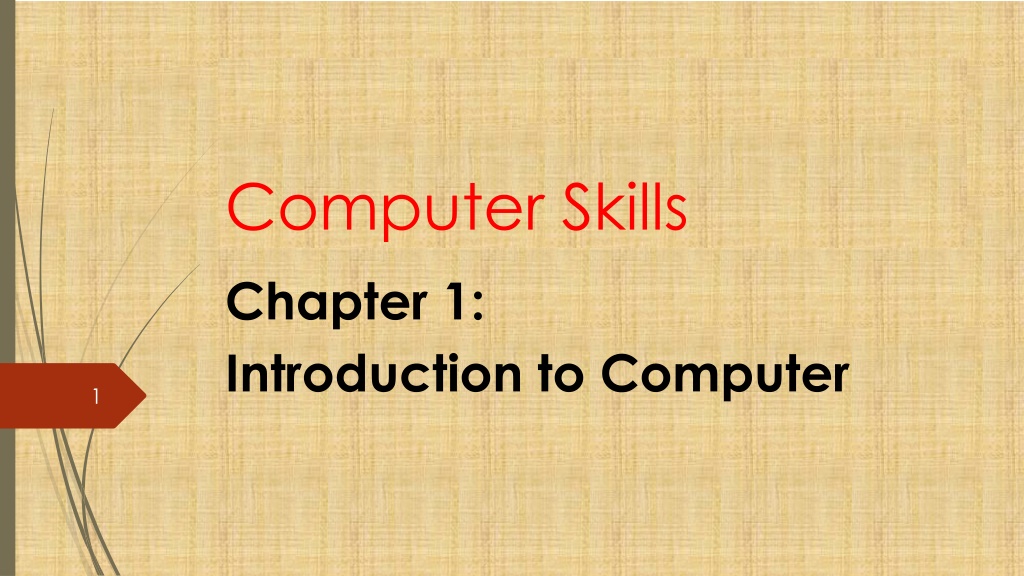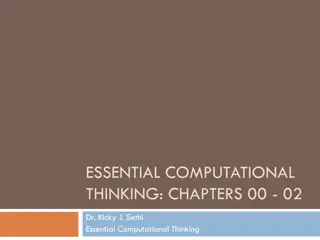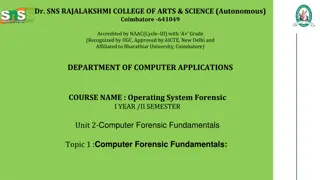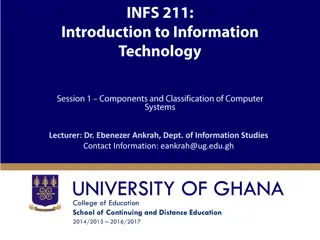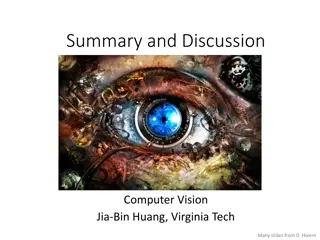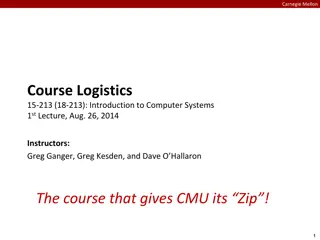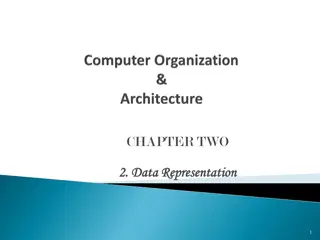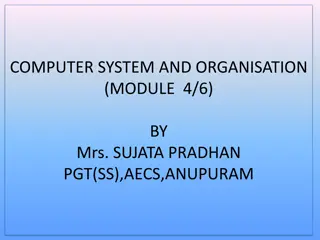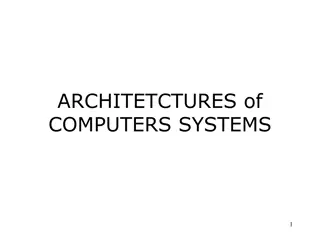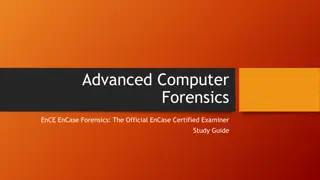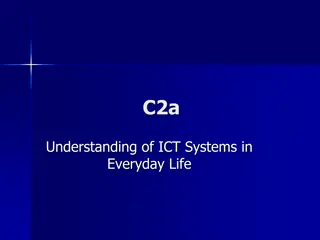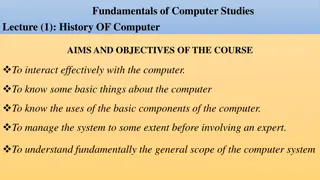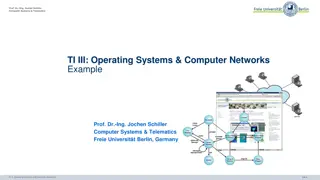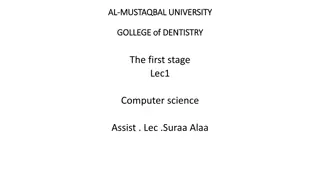Understanding the Fundamentals of Computer Systems
Explore the essential components and functionalities of a computer system, from hardware to software, input and output devices, and processing data. Learn how computers accept data, process it, and generate useful information for various applications.
Download Presentation

Please find below an Image/Link to download the presentation.
The content on the website is provided AS IS for your information and personal use only. It may not be sold, licensed, or shared on other websites without obtaining consent from the author. Download presentation by click this link. If you encounter any issues during the download, it is possible that the publisher has removed the file from their server.
E N D
Presentation Transcript
Computer Skills Chapter 1: Introduction to Computer 1
Computer 2 A computer is an electronic device, operating under the control of instructions stored in its own memory that can accept data (input), process the data according to specified rules, produce information (output), and store the information for future use
Functionalities of a computer 3 Any digital computer carries out five functions in gross terms: Takes data as input. Stores the data/instructions in its memory and use them when required. Processes the data and converts it into useful information. Generates the output Controls all the above four steps
Functionalities of a computer(Contd.) 4 Processing Data Information
Computer Components 5 Hardware Software
Hardware 6 Computer hardware is the collection of physical elements Tangible objects that constitutes a computer system. The actual machinery, wires, transistors, and circuits etc.
Software 8 Computer Programs instructions and data
Computer Units 9 1.Input Unit 2.Central processing Unit 3.Primary Memory Unit 4.Secondary storage Unit 5.Output Unit
Input Devices 10 Input device is any peripheral (piece of computer hardware equipment to provide data and control signals to an information processing system such as a computer or other information appliance. Input device Translate data from form that humans understand to one that the computer can work with. Most common are keyboard and mouse
Example of Input Devices 13 Keyboard Mouse (pointing device) Microphone Touch screen Scanner Webcam Touchpads MIDI keyboard Graphics Tablets Cameras Pen Input Video Capture Hardware Microphone Trackballs Barcode reader Digital camera Joystick Gamepad Electronic Whiteboard Note: The most common use keyboard is the QWERTY keyboard. Generally standard Keyboard has 104 keys
Central Processing Unit 14 CPU known as microprocessor or processor It is responsible for all functions and processes
CPU Components 15 The CPU is comprised of three main parts 1. ALU (Arithmetic Logic Unit) 2. Control Unit (CU) 3. Registers: Stores the data that is to be executed next.
ALU 16 Executes all arithmetic and logical operations. Arithmetic calculations like as addition, subtraction, multiplication and division. Logical operation like compare numbers, letters, or special characters
Control Unit (CU) 17 Control Unit (CU): controls and co-ordinates computer components. Read the code for the next instruction to be executed. Increment the program counter so it points to the next instruction. Read whatever data the instruction requires from cells in memory. Provide the necessary data to an ALU or register. If the instruction requires an ALU or specialized hardware to complete, instruct the hardware to perform the requested operation.
Registers 18 Registers :Stores the data that is to be executed next, "very fast storage area".
Primary Memory 19 1. RAM. 2.ROM
Primary Memory 20 1. RAM: Random Access Memory: is a memory scheme within the computer system responsible for storing data on a temporary basis, so that it can be promptly accessed by the processor as and when needed. It is volatile in nature, which means that data will be erased once supply to the storage device is turned off. RAM stores data randomly and the processor accesses these data randomly from the RAM storage. RAM is considered "random access" because you can access any memory cell directly if you know the row and column that intersect at that cell.
Primary Memory 21 2. ROM (Read Only Memory): ROM is a permanent form of storage. ROM stays active regardless of whether power supply to it is turned on or off. ROM devices do not allow data stored on them to be modified.
Secondary Memory 22 Stores data and programs permanently its retained after the power is turned off Main Examples 1. Hard Disk 2. Optical Disk 3. Flash memory
Hard Disk 23 Called Disk drive or HDD stores and provides relatively quick access to large amounts of data. Stores data on an electromagnetically charged surface or set of surfaces.
Optical Disk & Flash 24 an optical disc drive (ODD) is a disk drive that uses laser light to store data. There are three main types of optical media: CD, DVD, and Blu-ray disc CD Compact Disk can store up to 700MB DVD Digital Video Disk can store up to 8.4 GB Blu-ray disc. can store up to 50 GB
3. Flash Disk 25 A storage module made of flash memory chips. A Flash disks have no mechanical platters or access arms, but the term "disk" is used because the data are accessed as if they were on a hard drive. The disk storage structure is emulated.
RAM V.s Hard Disk 26 What are the differences between RAM as a main memory and HDD as a Secondary Memory.
Output Unit 28 An output device is any piece of computer hardware equipment used to communicate the results of data processing carried out by an information processing system (such as a computer) converts the electronically generated information into human-readable form.
Output devices Examples 29 Monitor LCD Projection Panels Printers (all types) Plotters Projector Computer Output Microfilm (COM) Speaker(s)
Output devices Examples 30 1. A monitor CRT: Cathode Ray Tube LCD: Liquid crystal display most familiar these days
Output devices Examples 31 2. Printer: transfers data from a computer onto paper Printer types: 1-Laser Printer. 2-Ink Jet Printer. 3-Dot Matrix Printer
Software 32 Software is a generic term for organized collections of computer data and instructions, often broken into two major categories two major categories: 1. system software 2. application software
System software Known as Operating System is responsible for controlling, integrating, and managing the individual hardware components of a computer system Windows is an example of OS. 33 example of System Software: 1) Microsoft Windows 2) Linux 3) Unix 4) Mac OSX 5) DOS
Application software 34 is used to accomplish specific tasks other than just running the computer system. It may consist of: a single program, such as an image viewer; a small collection of programs (often called a software package) that work closely together to accomplish a task, such as a spreadsheet or text processing system; a larger collection (often called a software suite) of related but independent programs and packages that have a common user interface or shared data format, such as Microsoft Office,
Unit of Measurements - Storage 36 Storage Units Bit BIT 0 or 1 Byte B 8 bits KB 1024 bytes Kilobyte MB 1024 kilobytes Megabyte GB 1024 megabytes Gigabyte Terabyte TB 1024 gigabytes
Size example 1 bit - answer to an yes/no question 1 byte - a number from 0 to 255. 90 bytes: enough to store a typical line of text from a book. 4 KB: about one page of text. 120 KB: the text of a typical pocket book 3 MB - a three minute song (128k bitrate) 650-900 MB - an CD-ROM 1 GB -114 minutes of uncompressed CD-quality audio at 1.4 Mbit/s 8 -16 GB - size of a normal flash drive 37
38 A. 10B is equivalent 10 * 8 = 80 bits B. 3MB is equivalent to how many Bits? Answer: 3 *1024 = 3072 KB 3072*1024 = 3145728 B 3145728 * 8 = 25165824 bits
Unit of Measurement -Speed 39 The speed of CPU measured by unit called Hertz (Hz) 1 Hz represent 1 cycle per second. The speed of CPU is known as Computer Speed.
Unit of Measurement -Speed 40 CPU SPEED MEASURES 1 cycle per second 1 million cycles per second or 1000 Hz 1 billion cycles per second or 1000 MHz 1 hertz or Hz 1 MHz 1 GHz
Computer Classification 41 Computers can be classified by size and power to: 1. Personal computer (PCs) 2. Workstation: 3. Minicomputer 4. Mainframe: 5. SuperComputer
Computer Classification 42 Personal computer (PCs): a small, single-user computer based on a microprocessor. In addition to the microprocessor, a personal computer has a keyboard for entering data, a monitor for displaying information, and a storage device for saving data. Workstation: a powerful, single-user computer. A workstation is like a personal computer, but it has a more powerful microprocessor and a higher-quality monitor.
Computer Classification 43 Minicomputer: multi-user computer capable of supporting from 10 to hundreds of users simultaneously. Mainframe: powerful multi-user computer capable of supporting many hundreds or thousands of users simultaneously. Supercomputer: an extremely fast computer that can perform hundreds of millions of instructions per second.
Computer Classification 44 Compare between the previous type of computers based on Price Processing Speed Storage Capacity Powerful Single-user or Multi-user Computer Size Companies size
Laptop computer 45 is a portable computer. personal computer that can be easily carried and used in a variety of locations. run the same software and applications in PCs
Netbook Computer 46 A netbook is a type of laptop that is designed to be even more portable. Cheaper and less powerful than laptops or desktops. They are generally less powerful than other types of computers, but they provide enough power for email and internet access, which is where the name "netbook" comes from.
Mobile Devices 47 A mobile device is basically any handheld computer. It is designed to be extremely portable. Some mobile devices are more powerful Types: 1.Tablet Computers 2.Smartphones
Tablet Computers 48 designed to be portable. The most obvious difference is that tablet computers don't have keyboards or touchpads. Best used for tasks like web browsing, watching videos, reading e- books, and playing games.
Tablet Computers 49 The most obvious difference is that tablet computers don't have keyboards or touchpads. Instead, the entire screen is touch-sensitive, allowing you to type on a virtual keyboard and use your finger as a mouse pointer. Tablet computers are mostly designed for consuming media, and they are optimized for tasks like web browsing, watching videos, reading e-books, and playing games
Smartphones 50 a powerful mobile phone designed to run a variety of applications in addition to phone service. Compare it with the tablet? Internet access is an important feature of smartphones. (3G or 4G)(Wi-Fi Service)
